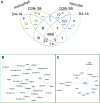AraLeTA: An Arabidopsis leaf expression atlas across diurnal and developmental scales
- PMID: 38428997
- PMCID: PMC11213249
- DOI: 10.1093/plphys/kiae117
AraLeTA: An Arabidopsis leaf expression atlas across diurnal and developmental scales
Abstract
Mature plant leaves are a composite of distinct cell types, including epidermal, mesophyll, and vascular cells. Notably, the proportion of these cells and the relative transcript concentrations within different cell types may change over time. While gene expression data at a single-cell level can provide cell-type-specific expression values, it is often too expensive to obtain these data for high-resolution time series. Although bulk RNA-seq can be performed in a high-resolution time series, RNA-seq using whole leaves measures average gene expression values across all cell types in each sample. In this study, we combined single-cell RNA-seq data with time-series data from whole leaves to assemble an atlas of cell-type-specific changes in gene expression over time for Arabidopsis (Arabidopsis thaliana). We inferred how the relative transcript concentrations of different cell types vary across diurnal and developmental timescales. Importantly, this analysis revealed 3 subgroups of mesophyll cells with distinct temporal profiles of expression. Finally, we developed tissue-specific gene networks that form a community resource: an Arabidopsis Leaf Time-dependent Atlas (AraLeTa). This allows users to extract gene networks that are confirmed by transcription factor-binding data and specific to certain cell types at certain times of day and at certain developmental stages. AraLeTa is available at https://regulatorynet.shinyapps.io/araleta/.
© The Author(s) 2024. Published by Oxford University Press on behalf of American Society of Plant Biologists.
Conflict of interest statement
Conflict of interest statement. None declared.
Figures







Similar articles
-
Stable and dynamic gene expression patterns over diurnal and developmental timescales in Arabidopsis thaliana.New Phytol. 2025 May;246(3):1147-1162. doi: 10.1111/nph.70023. Epub 2025 Mar 20. New Phytol. 2025. PMID: 40114416 Free PMC article.
-
Dual and spatially resolved drought responses in the Arabidopsis leaf mesophyll revealed by single-cell transcriptomics.New Phytol. 2025 May;246(3):840-858. doi: 10.1111/nph.20446. Epub 2025 Mar 3. New Phytol. 2025. PMID: 40033544 Free PMC article.
-
Inferring transcriptional gene regulation network of starch metabolism in Arabidopsis thaliana leaves using graphical Gaussian model.BMC Syst Biol. 2012 Aug 16;6:100. doi: 10.1186/1752-0509-6-100. BMC Syst Biol. 2012. PMID: 22898356 Free PMC article.
-
An Arabidopsis single-nucleus atlas decodes leaf senescence and nutrient allocation.Cell. 2025 May 29;188(11):2856-2871.e16. doi: 10.1016/j.cell.2025.03.024. Epub 2025 Apr 11. Cell. 2025. PMID: 40220755
-
Transcription factors regulating leaf senescence in Arabidopsis thaliana.Plant Biol (Stuttg). 2008 Sep;10 Suppl 1:63-75. doi: 10.1111/j.1438-8677.2008.00088.x. Plant Biol (Stuttg). 2008. PMID: 18721312 Review.
Cited by
-
The mRNA-binding protein HLN1 enhances drought stress tolerance by stabilizing the GAD2 mRNA in Arabidopsis.Stress Biol. 2025 Jun 6;5(1):39. doi: 10.1007/s44154-025-00239-4. Stress Biol. 2025. PMID: 40478352 Free PMC article.
-
Stable and dynamic gene expression patterns over diurnal and developmental timescales in Arabidopsis thaliana.New Phytol. 2025 May;246(3):1147-1162. doi: 10.1111/nph.70023. Epub 2025 Mar 20. New Phytol. 2025. PMID: 40114416 Free PMC article.
-
Decrypting plant tissues: From bulk to cell-type transcriptional profiles.Plant Physiol. 2024 Jun 28;195(3):1754-1756. doi: 10.1093/plphys/kiae190. Plant Physiol. 2024. PMID: 38561987 Free PMC article. No abstract available.
References
-
- Adrian J, Chang J, Ballenger CE, Bargmann BOR, Alassimone J, Davies KA, Lau OS, Matos JL, Hachez C, Lanctot A, et al. . Transcriptome dynamics of the stomatal lineage: birth, amplification, and termination of a self-renewing population. Dev Cell. 2015:33(1):107–118. 10.1016/j.devcel.2015.01.025 - DOI - PMC - PubMed
-
- Bastian M, Heymann S, Jacomy M, 2009. Gephi: an open source software for exploring and manipulating networks. In: Proceedings of the International AAAI Conference on Web and Social Media, California, USA, vol. 3, p. 361–362.
MeSH terms
Grants and funding
LinkOut - more resources
Full Text Sources

